5th June
Surprise, surprise, it was yet another beautiful morning, and the sea was like a mirror. Through the morning we chatted to a Dutch guy who had arrived through the night, and also a Finnish crew who had just moored adjacent to us. After a quick top up with water, we were on our way, hoping that the almost non-existent wind would pick up. Our destination was Kuressaare on the island of Saaremaa.
We motored a short way and then set our sails. Although there was not a lot of wind, there was enough to provide us with a lazy drift for most of the day, weaving a passage through islands, shoals and submerged rocks. It was idyllic. Towards evening the wind picked up a little, and as we passed Virtsu at midnight, a ferry crossing to the island of Muhu generously changed his course so as to slip behind us. Who says ships no longer give way to sail.
6th June
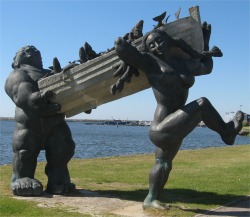
Suur T�ll and Piret
|
We slowly forged ahead, shifting our course around to the south of Saaremaa. Kiitaja's batteries were low on charge, not having been charged since we left Tallinn five days ago, so on went the motor to breathe some life into them. However, during this time the wind had shifted to almost astern of us, but sadly of insufficient strength to give us steerage. Thus our dream of sailing all the way to Kuressaare came to a premature end.
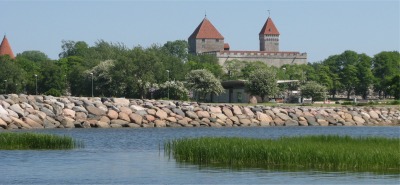
|
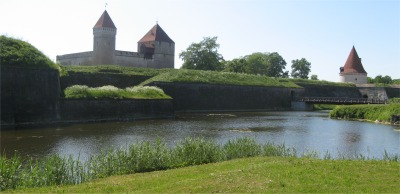
Kuressaare Fortress
|
As we motored the last few miles, I passed a yacht coming the other way, exchanging the usual courtesy wave with its skipper. At first he gave a casual wave, then he and his crew all started waving frantically. Since I was rather preoccupied with steering the boat, I thought nothing more of it. A minute later a call came over VHF channel 16, "Yacht Kiitaja, Yacht Kiitaja". Somewhat surprised I responded, we both changed to channel 67, and had a chat. It transpired that the yacht that had just passed us was a British yacht. We exchanged pleasantries, where we had been and where we were headed. They advised on the long narrow entry channel into Kuressaare marina, and we wound up wishing each other safe journey and fair winds. The yachting fraternity is just one big happy family.
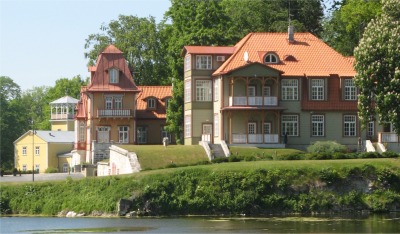
Ekesparre Residence Hotel
|
The approach into Kuressaare was indeed tight, through a very narrow channel with dredged waste dumped on the sides, occasionally forming narrow dry spits. It was well over a mile down this channel to the marina entrance. Once in the marina, a chap was standing on a pontoon directing us to a berthing point. It turned out he was the harbour master. He was ever so friendly and helpful, and we were soon inundated with literature about the town and island. He explained that he knew of our arrival well before we reached Kuressaare waters. Apparently the Estonian coastguard had been tracking our every movement on radar ever since we left Haapsalu, and had informed him that we were heading to Kuressaare. Crumbs, and I thought the Russians were bad.

Windmill, Operational 1899 - 1939
|
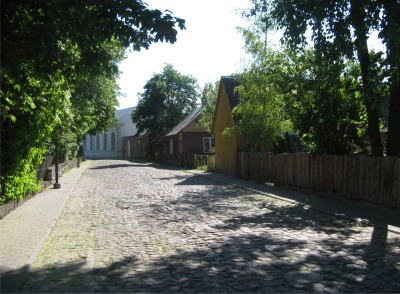
Typical Cobbled Street
|
Alan wanted a shower and kip, so I decided to do a quick reconnoiter of the town. Walking along the side of the marina, I passed fitness centres and spa hotels. In the 1820s, curative sea mud was discovered and in 1824, the first spa in Estonia was built in Saaremaa. Kuressaare had been an important health resort since the 19th century, and was the first city in Estonia to become a member of the European Healthy Cities Network in 1998. I was momentarily distracted by the sight of a naked couple carrying a rowing boat full of fish. It was a sculpture by Tauno Kangro, depicting the heroic giants, Suur T�ll and Piret, of Saaremaa mythology.
I walked around the moat of Kuressaare Fortress before heading to the city centre. Monastic chanting emanated from the fortress, but I didn't investigate, I'd leave that until Alan was around too.
Kuressaare, with its population of 15,000, was the only city on Saaremaa. In 1227 the Teutonic Knights broke the resistance in Saaremaa, and a fortress was built as the local stronghold of the Bishop in the 14th century. In 1559, Bishop Munchhausen sold his estates in Saaremaa to Frederick II, the King of Denmark, and the Danish occupation began. Russian occupation began in the beginning of the 18th century and lasted until 1917.
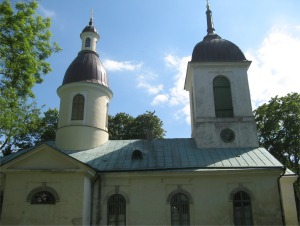
St Nicholas Orthodox Church
|

Suursila Bridge
|
The triangular central "square" was home to the Town Hall, a simple and austere Baroque style 17th century building. Opposite stood the Weighing House, also built in the 17th century, and was the only surviving representative of this type of building in Estonia. The weighing-house contained accurate and sealed scales which facilitated trade. A deserted market idled the day away just off the square. A sprinkling of coffee houses, restaurants and shops tried to add gravitas to the square. The city was basically a small town. Nearby I located St Nicholas Orthodox Church, the oldest building on the island.
I explored back streets, still cobbled as they were centuries earlier. Passing by quaint wooden buildings with semi-hip roofs, I approached the outskirts of the city which were now full of rows of 3/4 storey apartment blocks.
I was making for Suursila Bridge on the perimeter of town. This bridge of superlatives was the oldest, largest, and longest stone bridge in Estonia, and had a preservation order placed on it in 1990. Having satisfied my curiosity and walked over the bridge, I headed back for food and sleep.
7th June
The wind forecasts were promising good SE winds for the next two days, so Alan was keen to set off to new pastures later today. We planned a rough agenda for the day, culminating in a sauna which we booked for 2pm.

Episcopal Castle
|
Our main focus was the castle, built in the second half of the 14th century, and the best preserved medieval castle in the Baltic countries. We accessed the building via a small courtyard, which led off to a veritable warren of staircases and walkways leading off to rooms at various levels in the fortress. Each room displayed a stage in the history of the island, which I found all extremely interesting. I learned through the course of the visit that Estonia had been occupied by the Russians from 1710 until the war of independence in 1918-20. A period of self rule followed, but was shattered when the Germans invaded during World War II, only to be pushed out by the Russians towards the end of the war. The Russians stayed on and kept control of the country through state control and collective farming. Life for the Estonians under Russian rule was not easy. Many escaped to Sweden in rowing boats. The occupiers even had missile sites on the island up until 1991. It was on 20th August, 1991, that the Estonians finally wrenched themselves free of the Russians. No blood was spilt, but the Russians never made it easy. Latvia and Lithuania also won their independence from Russia the same year, though blood was shed.
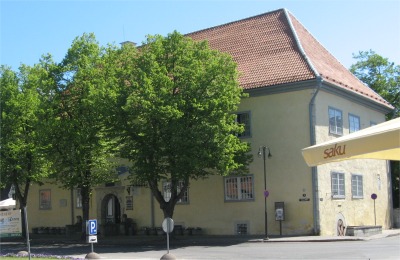
Town Hall
|
It was in the fortress where I came across a couple of English cyclists. They had flown out to Tallinn with their bikes, and were cycling 800km around Estonia over two weeks. The land being predominantly flat made it easy for them, but sometimes they found themselves ploughing into head winds, which made progress painfully slow. At times they were cycling through beautiful meadows, though cattle seemed to be a rarity. Then there were times when they were passing through a straight corridor between trees for many tens of miles; not surprising since just less than half the country was forested. We wished each other good luck on our respective journeys. As Alan and I wandered into town later on, a big ,"Hello!" turned out to be the same two guys passing us on their next leg of their trip.

Weighing House
|
In town, we sought out a hairdressers. Alan was asked how many millimeters of hair he wanted left on his head, to which he responded with nine. I just asked for a number one, which seems to be universally understood, apart from in Estonia. The poor girl had no concept of what I meant, so I picked up her razor and set it to the shortest setting. She then went to work with a big smile, and in no time at all I was left with a whisper of hair - ideal! She only charged three Euros, well below home prices, so I left her a handsome tip.

The Sun Sinking on My Watch
|
After a beer and some delicious Russian meat and tomato soup in the square, we returned back to the marina for our sauna. This was Alan's first. I think he might have got a minute sense of enjoyment from the experience; whether he partakes in another remains to be seen.
Later, as we recovered from our thermal shock treatment, we greeted a Dutch boat that had just sailed from Ventspils, on its way to Haapsalu. Accounts were swapped of the ports we had just sailed from. Ventspils was our next port of call, and we were left with that wondering feeling about what we were letting ourselves in for.
As we said farewell to the harbour master, who was probably well into his 60s, we asked him what life was like under Russian rule. He was almost spitting blood as he made it clear that it was not very pleasant. However, most of them were gone now, and the few Russians that were left were "good" Russians.
We cast off in the early evening with a good SE wind, and Alan actually sailed the boat down the long, narrow entrance channel instead of motoring. Our course was then set for Ventspils in Latvia. I undertook the last watch of the day with the sun sinking down, and the S�rve lighthouse on the southern tip of Saaremaa starting up its nightly twinkle. We were making good speed until my watch was about over, when the wind suddenly changed direction and then decided to drop completely. Alan pulled himself together for the graveyard watch, and I left him to make what he could of our new circumstances as I settled down for a kip.












